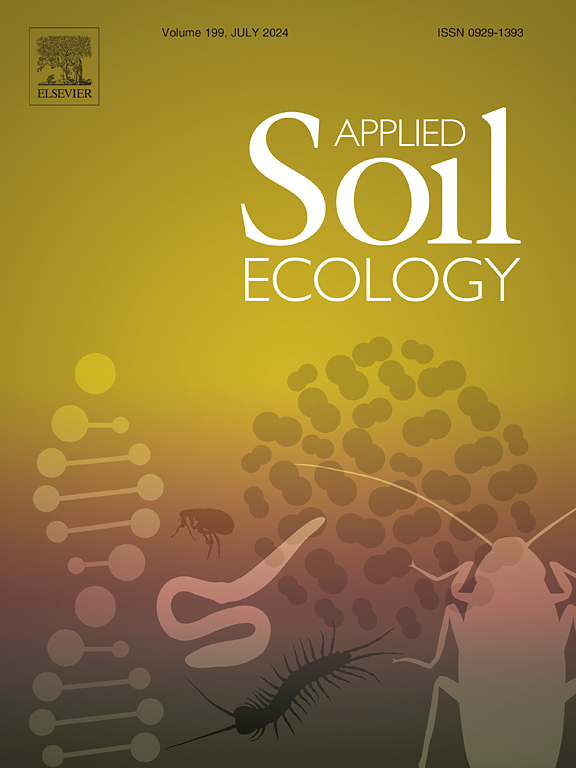The role of fungal keystone taxa in soil multifunctionality across subtropical forests
IF 4.8
2区 农林科学
Q1 SOIL SCIENCE
引用次数: 0
Abstract
Soil multifunctionality plays a crucial role in ecosystems, not only supporting nutrient cycling and plant productivity but also preserving biodiversity, thus ensuring the health and stability of the ecosystem. Forest soils harbor highly diverse microbial communities which fundamentally regulate the global elemental cycle and ecosystem multifunctionality. Keystone taxa act as “goalkeeper” in microbial community, which deeply portray community composition and functions. However, the mechanisms through which keystone taxa of soil microbes influence the dynamics of soil multifunctionality remain insufficiently elucidated within forest ecosystems. Our study analyzed the soil microbial community structures, soil properties and multifunctionalities of three typic forest stands in subtropic areas in south China, and identified the keystone taxa of bacteria and fungi by constructing co-occurrence networks, respectively. Further, partial least squares path modeling (PLS-PM) was conducted to explore the impact of different microbial taxa on soil multifunctionality. Our findings revealed considerable changes in soil multifunctionality across various forest types, with broad-leaved forest being the highest, then the mixed forest, and then followed by the coniferous forest. Compared with bacterial communities, soil fungal microbial networks in forest ecosystems had higher network nodes and higher module aggregation. Comparative analyses revealed that fungi exhibited greater type heterogeneity relative to bacteria inter-forest, with fungal keystone taxa demonstrating a pronounced influence on the multifaceted functional capacities of soil ecosystems. PLS-PM analysis further confirmed that soil properties (SOC, TN, and MBC) and fungal keystone taxa diversity (r = 0.319, p < 0.05) exert significant direct effects on soil multifunctionality. Furthermore, the total effects analysis highlighted fungal keystone taxa diversity and soil properties were critical determinants of soil multifunctionality. Additionally, this study emphasizes the significance of keystone fungal species in controlling soil multifunctionality in forest ecosystems. Promoting the diversity and abundance of fungal keystone taxa is essential for maintaining and enhancing soil multifunctionality, thereby supporting forest ecosystem health and productivity.

亚热带森林真菌关键分类群在土壤多功能性中的作用
土壤多功能性在生态系统中起着至关重要的作用,不仅支持养分循环和植物生产力,而且还保护生物多样性,从而确保生态系统的健康和稳定。森林土壤具有高度多样化的微生物群落,它们从根本上调节着全球元素循环和生态系统的多功能性。关键类群在微生物群落中扮演着“守门员”的角色,深刻地刻画了群落的组成和功能。然而,在森林生态系统中,土壤微生物的关键分类群影响土壤多功能性动态的机制尚未得到充分阐明。本研究分析了中国南方亚热带地区3个典型林分的土壤微生物群落结构、土壤性质和多功能,并通过构建共生网络分别确定了细菌和真菌的重点类群。利用偏最小二乘路径模型(PLS-PM)探讨不同微生物类群对土壤多功能性的影响。结果表明,土壤多功能性在不同森林类型间存在显著变化,阔叶林土壤多功能性最高,其次是混交林,其次是针叶林。与细菌群落相比,森林生态系统土壤真菌微生物网络具有更高的网络节点和更高的模块聚集性。对比分析表明,真菌在林间表现出更大的类型异质性,真菌的关键分类群对土壤生态系统的多方面功能能力有显著影响。PLS-PM分析进一步证实了土壤性质(SOC、TN和MBC)和真菌关键分类群多样性(r = 0.319, p <;0.05)对土壤多功能性有显著的直接影响。此外,总效应分析表明,真菌关键分类群多样性和土壤性质是土壤多功能性的关键决定因素。此外,本研究还强调了关键真菌物种在森林生态系统土壤多功能性控制中的重要意义。促进真菌关键分类群的多样性和丰度对于维持和增强土壤的多功能性,从而支持森林生态系统的健康和生产力至关重要。
本文章由计算机程序翻译,如有差异,请以英文原文为准。
求助全文
约1分钟内获得全文
求助全文
来源期刊

Applied Soil Ecology
农林科学-土壤科学
CiteScore
9.70
自引率
4.20%
发文量
363
审稿时长
5.3 months
期刊介绍:
Applied Soil Ecology addresses the role of soil organisms and their interactions in relation to: sustainability and productivity, nutrient cycling and other soil processes, the maintenance of soil functions, the impact of human activities on soil ecosystems and bio(techno)logical control of soil-inhabiting pests, diseases and weeds.
 求助内容:
求助内容: 应助结果提醒方式:
应助结果提醒方式:


